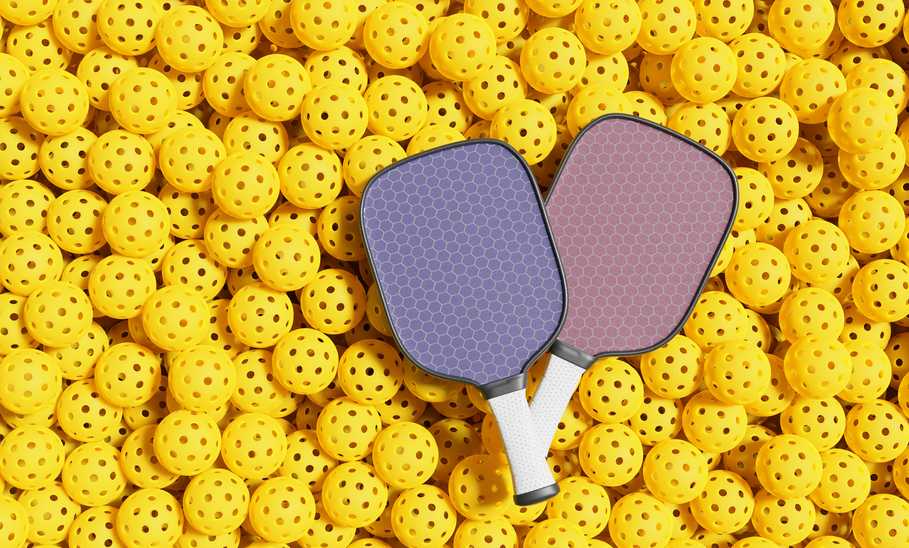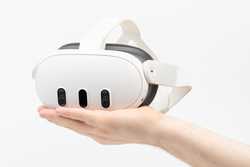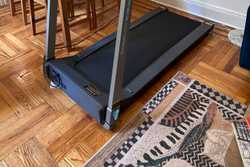- Core materials: Aluminum
- Surface materials: Aluminum
- Shape: Wide, rounded
- Weight: 10 ounces
- Handle length: 6 Inches
- Grip circumference: 4.25 inches
The Best Pickleball Paddles To Dominate the Game in 2024

Our evaluations and opinions are not influenced by our advertising relationships, but we may earn a commission from our partners’ links. This content is created by TIME Stamped, under TIME’s direction and produced in accordance with TIME’s editorial guidelines and overseen by TIME’s editorial staff. Learn more about it.
Pickleball, the innovative sport that any age can play, continues to grow in popularity across the United States. (Much to the chagrin of tennis players looking to use their local tennis court.) It’s been growing steadily ever since its humble origins in 1965, and as long as you have a pair of comfortable tennis shoes, plastic pickleball, aforementioned court, and a paddle, you can get in the game, too. With a huge range of pickleball equipment brands on the market offering their own unique models in a variety of sizes, shapes, and playstyles, newcomers may not know how to find the best paddle to suit their needs on the court. After personally taking up plenty of paddles and icing our pickleball elbows afterward, we can safely point brand-new and longtime pickleball players alike towards our top picks, as well as what to look for when selecting a new paddle.

Unfortunately, many sports can be quite the investment to get into, but if you’d like to try pickleball for the first time or lure a friend to play with you, these inexpensive, yet solid pickleball paddles are worth the price of admission. Paddles are rarely made of aluminum, but despite the fairly weighty design, these metal paddles are remarkably sturdy and are well-suited for players to enjoy smashing power shots over the net. We were particularly impressed at how comfortable its padded EVA plastic grip was for the low price, which helps to offset the feel of swinging a heavier paddle. Sure, these are a far cry from professional-grade paddles, but this bulkier model is a rock-solid way to see if pickleball is for you, without putting too large of an investment into the sport.
If you’re interested in learning Pickleball, this especially inexpensive model feels and performs better than you may expect.

There are many reasons why fresh-faced pickleball players should consider a Joola Journey as their first paddle: There’s the cozy, tactile feel of its standard grip, the way it sports a balanced design for reliable power plays and ball control, its reinforced edges to ensure that despite accidental taps, their first paddle will last a while, as well as how its lightweight feel makes it easier to practice for longer. The Journey is available in a rainbow of eye-catching colors, has a cozy smaller grip that big kids and beginners will feel comfortable with, and a wide sweet spot that comes in handy when you’re learning how to reliably return basic shots. The Journey is a rock-solid pick for anyone lacing their tennis shoes and hitting the court for the first time, and it’s versatile enough to last long after they become comfortable with the game.
Joola’s Journey is a comfortable, durable, and versatile Pickleball paddle with a lightweight feel and a generous sweet spot for helping newcomers reliably send the ball back over the net.

Mid-Level pickleball players who enjoy having fun, yet are still learning what their signature style is, should pick up one of these all-around great paddles. Featuring a comfortable textured standard grip, a rugged velvety face texture that provides plenty of spin, and a reliable balance of power and ball control, the maneuverable Paddletek Bantam EX-L is a versatile pick to play with until you feel the need for a more specialized paddle. In addition, the EX-L features a large sweet spot, a durable design made to last, and is available in several vibrant colors.
The Bantam EX-L sports above average stats across the board, making it a top pickleball paddle to help players discover their preferred playstyle.

We got our hands on the orange variant of the four Vulcan V910 16mm pickleball paddles, but after plenty of time on the court, we recommend high-level players check out all four options to see which version best suits their play style. In general, though, the ultra-rugged carbon fiber surface feels extremely sturdy despite its lightweight design, it sports a rather generous sweet spot, and a premium shock-adsorbing core that lets us play harder for longer without feeling it later. The orange variant we played with excelled at power shots due to its aerodynamic oval shape, allowing for swift, yet consistently forceful shots, with a surprisingly precise level of control and spin for what feels like a power-focused design. Experienced players will definitely appreciate the variety of specialized pickleball paddles in the V900 series.
If you’ve been playing pickleball for a while, you’ll appreciate the exceptionally high level of control this paddle adds to each shot.

In a world of mediocre pickleball paddle designs, JOOLA’s Magnus 3 caught my attention with its slick carbon black and neon pink gradient style, but I highly recommend this elongated model for its ability to put a ton of spin into your shots with little effort. While this Tyson McGuffin-inspired pickleball paddle is a strong contender for the best power paddle on this list, the combination of its ultra-rugged Carbon-Flex5 textured surface and unique propulsion core makes this the best paddle on the market for players who want to put the perfect amount of spin into their shots.
The shorter handle and elongated paddle deliver a high level of control, but its trampoline-like propulsion core is the star feature of the Magnus 3; you may be familiar with polymer core paddles, but the Magnus 3 features a connective foam layer between the inner honeycomb polymer and its outer edges that provides a substantial amount of power due to the flexible “trampoline effect” of each impact, and coupled with its extra-grippy carbon surface, its additional dwell time makes it a snap for pro players to add plenty of spin to their power shots.
Power-players will need to ease up on their shots, as the Magnus 3 does more work than they may expect, and weaker players will be thrilled at how much less force it takes to efficiently make high-impact plays too. Beginners will enjoy the bonus power a Magnus 3 brings to the table, and although advanced players may need a little time to adjust to its built-in power, they will quickly learn to love how its springy core and carbon friction surface helps to add significant spin to their shots.
Optimized for an effortless and noticeable boost in both spin and power, Joola’s Magnus 3 is a heavy-duty heavy hitter that players of all skill levels will appreciate.

Although its steep price tag will prevent it from getting in the hands of every power pickleball player, the Invikta is worth every cent for dependably smashing the ball with precision and finesse. At eight ounces, it may seem lightweight for a power paddle, however this carbon fiber model’s edgeless design and innovative throat opening allows it to slice through the air with extra force, for added force per shot without the heft of a thicker paddle holding you back. The Invikta is also notable for its premium elongated grip, longer sweet spot, durable feel, and textured face for serving up forceful and consistent angles and curves at a moment’s notice. If you’re a power player who isn’t a fan of thicker and heavier paddles, this one’s for you.
Pickleball players who love the idea of a “lightweight” paddle for consistent power shots will value how the swift, yet powerful feel of the Power Air Invikta.
Advanced players looking for a pickleball paddle to send the ball with laser-guided missile precision will want to check out this blazing orange model. Its edgeless frame and fairly light and thin design allow it to cut through the air for speedier play, while the CX11E Control Orange’s unique textured surface makes putting as much or as little spin on your returns as you want a snap. In addition to being noticeably quieter than most pickleball paddles, and sporting a sizable sweet spot, its face feels “grippier” as well, allowing control-type players to arc, angle, and drop the ball and outplay their opponents.
Gearbox did everything they could to make the CX11E Control Orange featherweight and slim, and its sizable sweet spot and grippy textured edgeless face provides far more control than the average paddle.

Since there aren’t many pickleball paddles made for kids that are both rugged and affordable, this cool, shark-themed model easily stood out from the pack. The megalodon paddle features a lightweight design with a shorter grip that makes it far easier to hold and swing than adult-sized paddles, with the added benefits of an extra-large sweet spot that makes learning how to serve and return the ball more engaging and fun for newcomers. Joola’s kid-sized pickleball paddle features a balanced design that is equally suited to power shots and ball control, but we got a surprising amount of spin on our shots via its fiberglass textured face. Bigger kids may feel more comfortable playing with a featherweight adult-sized paddle, but this is an excellent paddle to introduce younger players to the sport.
Its comfortable and small grip, above-average control, and cool shark motif makes this the top kid-friendly pickleball paddle on the market.

Not only is this kit an excellent deal, since it includes two pickleball paddles, a carrying bag, two rolls of grip tape, and four balls, these USAPA (USA Pickleball) approved paddles are comfortable, optimized for a bit of extra power in each shot, and are available in a large range of vibrant and fun designs. Great for beginners and intermediate players, Niupipo paddles are sturdy, on the lighter side, and function well as a generalist paddle that provides reliable spin and control due to its textured fiberglass face. You may be skeptical of these paddles because of their low price point, but the durability and performance makes them well-worth a try for newcomers.
These fairly priced Pickleball paddles are more than a pretty face due to their big sweet spots and high level of control.
There are a few key factors to consider to narrow down the search for the best pickleball paddle for your unique gameplay needs:
Although the standard grip size of four to five inches will comfortably fit most pickleball players, those with larger or smaller hands may need a paddle grip to match. This is surprisingly important, as your grip directly affects not just your comfort, but the ball control and overall accuracy of your gameplay.
A paddle’s weight directly affects your gameplay; heavyweight paddles of ten ounces and above are well-suited for power shots, while lightweight models of seven ounces or less are made for speedier play and additional control. Beginners will appreciate midweight paddles, as they offer a reliable balance between power and control, and advanced pickleball players may lean towards a heavier or lighter paddle to better suit their playstyle.
A paddle’s shape impacts the size of its “sweet spot,” or the area of its face optimized for hitting the ball, as well as its reach. Most paddles utilize a square shape with rounded edges, offering a large sweet spot that beginners will appreciate. Rectangular paddles may have a slightly smaller sweet spot, but the extended reach is worth it for some players.
Experienced players may prefer an oval or teardrop shaped paddle, and although they have a much smaller sweet spot, these accurate players will appreciate the lighter feel, additional reach, and extra spin these advanced models provide.
There is no one-size-fits-all “best” pickleball paddle, but there are certainly models that are the best within their niche (control, spin, strength, etc.), and although it took plenty of research and testing to identify the most effective models for various proficiency levels and playstyles, and to find out for myself if each paddle lived up to the hype, these were the most important considerations I had while making this list:
Whether it is a heavyweight model with a highly textured surface for power shots and maximum spin, or an elongated edition with a smoother face for a longer reach and more control, any paddle worth recommending needs to perform well in its specific niche. A paddle’s weight, thickness, grip size and length, core materials, edge guard or a lack of one, and texture are all worth considering before you buy, and between their popularity with verified buyers and my experience, these paddles all meet or exceed expectations.
Novice pickleball players will want a paddle with more control and a bigger sweet spot for easier returns as they become acquainted with the sport, but there is no reason for beginners to overspend for more than what they should for a relatively basic model while they learn the ropes. Mid-level and advanced players who have developed a preferred playstyle and appreciate the feel of certain paddle grips, weights, and shapes over others should absolutely invest in a paddle that perfectly syncs with their skill level and approach.
The overall value for the intended level of ability, durability, and performance of each paddle when compared to its price was a vital factor for picking out the best models available today.
Pickleball paddles are most easily categorized by their materials and shape, and there are many combinations of these available to accommodate fresh-faced beginners and seasoned pros, who may prefer models designed for extra ball spin or power shots.
Most paddles are composed of fiberglass, graphite, carbon fiber, polymers, aluminum, or even wood. Each material has its own perks and drawbacks, such as additional ball control at the expense of power shots, or a heavier paddle for power shorts that is a bit slower to swing through the air.
Paddles are generally made in four core shapes: Square, rectangle, oval, and teardrop. Square and rectangle paddles sport a large and forgiving “sweet spot” for easily hitting the ball back, making them a top option for beginners, while alternative paddle shapes are geared towards advanced players who are happy to trade a smaller target zone for a much more aerodynamic design for faster gameplay.
Although heated gameplay and time will naturally wear down your pickleball paddles, there are a few key tips to keep them on the court in tip-top shape for as long as possible:
There are many premium pickleball paddle manufacturers on the market, including Joola, Niupipo, Paddletek, and Vulcan. Joola is a particularly popular brand, as pickleball champion Ben Johns personally uses a Joola Perseus CFS 16 paddle, and top-10 player Collin Johns plays with a Joola Scorpeus CFS 16.
There is no set perfect weight and size of a pickleball paddle, because every player has their own preferences, style, and level of experience that help to determine the best paddle for their personal needs. With that said, lightweight pickleball paddles weigh six or seven ounces, while heavier models weigh in at ten ounces and up. Generally speaking, lightweight paddles provide more control and speedier play, while heavier options trade that finesse for reliable power shots. We recommend that beginners start with a mid-range pickleball paddle of seven to nine ounces, to learn whether they’d eventually prefer a lighter or heavier paddle in the future.
When it comes to shapes, pickleball paddles tend to be shaped in a rounded square, longer rectangle, oval, or a teardrop design. Each shape affects the size and location of the “sweet spot,” or the optimal part of the paddle to strike the ball; square and rectangular paddles have bigger sweet spots, making them a top pick for beginners, while oval and teardrop paddles ops for a lighter and more maneuverable overall design.
In a nutshell, it’s best to start with a midweight square or rectangular model, going from there once you learn your preferred playstyle in the future.
Graphite: These paddles sport a slim layer of graphite lining their paddle surfaces, and are some of the lightest options available. Graphite pickleball paddles are best known for speedy play and a higher level of control, at the cost of power and spin.
Composite: These paddles are composed of multiple materials, but most often carbon fiber, a polymer, or fiberglass. Composite paddles tend to provide more spin and power, but a bit less control and speed than their graphite counterparts.
Wood: Although wooden pickleball paddles tend to be affordable, rugged, and are usually optimized for power shots, these thick and heavy models aren’t known for their comfort, speed, and overall control.
The easiest and most reliable grip is to hold the handle as though you were shaking another player’s hand; simply place the grip across your hand with your thumb on one side and your four fingers curled around on the other side. Close your hand around the grip and keep the natural “Y” shape at the top of the grip that forms between your thumb and index finger pointed inward towards your body. This hold is most commonly known as the “continental grip.”
The average pickleball paddle may last anywhere from one to five years, depending on its construction and how often and how hard you play. If you notice a different sound coming from the paddle when you hit the ball, broken parts of the paddle, or a drop in performance, it’s probably time to replace your paddle with a new one.
The information presented here is created by TIME Stamped and overseen by TIME editorial staff. To learn more, see our About Us page.



